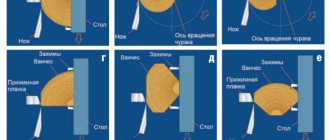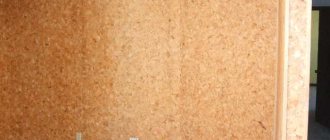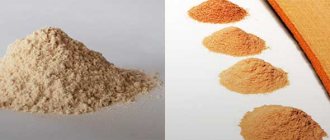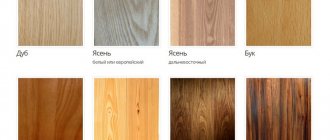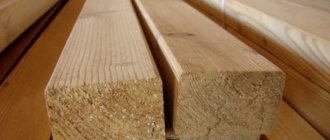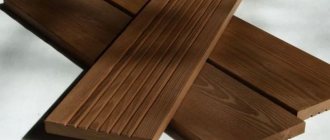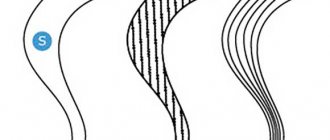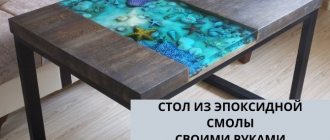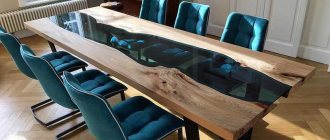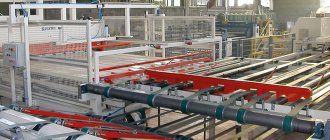The raw materials for the production of veneer and plywood are logs and their sections (churaks) that meet certain dimensional and quality requirements.
For laminated plywood, block lengths from 0.8 to 3.2 m are used, and for sliced veneer – from 1.5 m and above.
The cross-sectional dimensions of the raw material are not of fundamental importance. The minimum permissible size is determined by the economic feasibility of developing raw materials, and the maximum permissible size is determined by the size of the equipment. It is customary to use raw materials with a diameter of 18 cm and above, for sliced veneer - 22...26 cm and above.
Quality requirements boil down to limiting both wood defects (knots, abnormal coloring and rot, cracks, wormholes, etc.) and shape defects (primarily curvature).
The following types of wood are used:
- for the production of laminated plywood - birch, alder, beech, linden, aspen, pine, spruce, cedar, fir, larch;
- for the production of wood laminated plastics - birch;
- for the production of sliced veneer - oak, beech, walnut, maple, ash, elm, chestnut, plane tree, velvet, apple, pear, poplar, cherry, white acacia, birch, alder.
Procurement, delivery and storage of raw materials (logs) at plywood factories are carried out using methods similar to those already discussed. Preparation of raw materials for veneer production involves cutting logs into logs, hydrothermal treatment and debarking.
Cutting ridges into churaki
There are three cutting methods:
- by greatest mass,
- for the highest quality yield
- combined.
The goal of the first method is to obtain from each ridge logs with the largest cubic capacity, regardless of their quality. When cutting using the second method, the goal is to obtain high-grade churaki, regardless of the volumetric yield. Both of these methods are not used in their pure form. A combined method is advisable, which is based on obtaining maximum mass while maintaining the highest quality yield.
Cross-cutting of raw materials consists of two operations, usually combined in practice - marking ridges and sawing them into logs.
Marking consists of determining the cutting lines on the ridge, taking into account cutting out defective places, in order to obtain the largest number of the best quality logs with the least loss of wood.
The cut must be made with strict observance of the perpendicularity of the cutting plane to the axis of the trunk and the correct length of the block.
The logs, depending on the size, are sawn on circular sawing machines (TsPS-710 (Russia) (Fig. 1)) and pendulum machines (TsMZ, TsME-2, TsME-3K (Russia) (Fig. 2)), cross-saw machines with reciprocating motion saws or chain saws.
Rice. 1. Combined balancing circular saw TsPS – 710
Rice. 2. Pendulum circular saw machine TsME-3K
There is a “fox tail” machine with a reciprocating saw motion, used for cutting raw materials with a diameter of 70 to 150 cm.
The total loss of wood when cutting logs into logs is 1-3%, depending on the type of wood.
The productivity of circular saws in blocks per shift (A, blocks/cm) is determined by the formula:
(1)
where T is the duration of the shift, min; U – saw feed speed, m/min; КМ – coefficient of computer time utilization; KD – working time utilization factor; DC – block diameter, m; n – average number of cuts per block.
The logs are cut into logs with an allowance along the length for processing.
To obtain plywood measuring 1525x1525 mm, a block 1600 mm long is prepared, that is, with an allowance of 75...80 mm.
Hydrothermal wood treatment
During the process of peeling and planing veneer, tensile stresses arise in it across the fibers, the magnitude of which can be determined by the formula σ, MPa):
(2)
where E is the modulus of elasticity of veneer across the wood fibers; S – veneer thickness; R – block radius.
Cutting technology is considered as a process of obtaining a thin layer of wood, which must be dense and smooth (not have cracks).
During the cutting process, the layer being removed bends, changing its original shape, as a result of which cracks are possible on the left stretched side of the veneer.
To avoid cracks, the deformability of wood is artificially increased. To do this, churaki and vanches are subjected to hydrothermal treatment (humidification and heating).
The higher the moisture content of the wood, the greater its ductility. Dry wood has significant fragility.
Heating wood (to a certain limit) gives the fibers good plastic properties. High temperatures have a negative effect on the quality of veneer, since due to the strong softening of the fibers during cutting, a “hairy” surface appears.
Recommended temperature for heating wood before peeling and planing:
- Birch, beech, alder – 20…30 оС,
- Linden, aspen – 15...20 оС,
- Mahogany – 30…40 оС,
- Spruce – 20 оС,
- Pine – 40 °C,
- Larch – 50 °C,
- Ash – 50 oC.
Hydrothermal treatment can be carried out by heating in water: boiling or steaming.
Boiling is carried out in hot or warm water in special pools (open and closed), equipped with mechanisms for loading and unloading churak (Fig. 3). This method is simple and does not require large expenses for its organization; it is used mainly for peeling.
Steaming is used mainly in the production of sliced veneer, when cooking is unacceptable due to changes in the color of the wood. Steaming is carried out in autoclaves, steam chambers and pits.
Hydrothermal treatment before peeling can be carried out using soft and hard modes.
Soft – temperature 35...40 oC, heating duration 2...3 days, hard – temperature 70...80 oC, heating duration 2...15 hours.
Rice. 3. Swimming pool with a cantilever gantry crane for warming up churaks: 1 – dumper; 2 - loading conveyor; 3 – ridge storage; 4 – cover; 5 — grab grip; 6 – dividing cabinet; 7 – wall; 8 – tap; 9 – mobile reloader; 10 – unloading conveyor
Hydrothermal treatment before planing is carried out for a longer time: saturated steam temperature 120...130 oC, treatment duration 4...10 hours.
The duration of hydrothermal treatment generally depends on the diameter of the block, the type of wood, the temperature of the heating medium, the initial and final temperature of the wood.
Varieties of veneer
When choosing wood, experts pay attention to the quality of the material. Veneer is made from high quality raw materials.
Veneer is made from wood of different types of trees. Its shade varies from white to bright red.
The wood of the following trees is very popular:
- Pine. Veneer is characterized by its low cost. The wood is light in color. It is not subject to the appearance of fungus, and also has the properties of releasing phytoncides. The disadvantage is low wear resistance, so the manufactured veneer must be used carefully.
- Oak. Characterized by increased moisture resistance. Veneer made from oak wood has dark brown shades.
- Birch. Birch wood is a cheap material. The veneer has a beautiful natural wood color. If desired, it can be easily repainted in any other color.
- Linden. Its wood has a yellow-pink color. Veneer produced from linden is used in the manufacture of cheap furniture elements.
- Karelian birch. A rare type of wood. The material has a beige color with a slight pearlescent tint. Used in the production of expensive products.
- Cherry. The wood has a red-brown color. However, after a while it darkens. It is used in the production of high quality interior items.
- Maple. Maple is a cheap raw material. Used to create decorative elements. May be light or light yellow in color. Mainly used in the production of musical instruments.
The finishing material is made from any type of wood. Plates made from low-quality materials may appear to be made from high-quality raw materials in appearance.
Scarification
Baring - removing the bark from the logs before peeling protects the cutting tool from dulling and damage, reduces its wear, and also increases the productivity of the peeling machine.
The main requirements for the debarking process are cleanliness and preservation of the sapwood part of the churak wood (only the bark and bast should be removed).
Raw materials are debarked on various types of debarking machines (OK63-1F, OK80-1, 2OK63-1 (Russia), Valon Kone VK-26 (Finland)) or on peeling machines of a simplified design.
The hourly productivity of rotary debarking machines (A, m3/hour) is determined by the formula:
, (3)
where V is the volume of the ridge of average d, m3; Kz – machine load factor; L – ridge length, m.
For debarking hard and large wood, a hand-held electrified milling tool is most suitable. The rotation speed of its cutter head is 1500 min-1. The maximum thickness of the removed layer is 15 mm.
Peeling on peeling machines is carried out with the ruler withdrawn, that is, without crimping. It is produced on a peeling machine specially dedicated for this purpose, and then the logs are transferred to other peeling machines for processing.
Using this method, debarking is combined with cutting to a cylinder. The resulting partial-size veneer sheets are cut using guillotine shears directly at the machine. The advantages of this method are additional selection of raw materials in the form of pieces, less wear (dullness) of the knife, and increased productivity of peeling machines. The disadvantage is the increased yield of pieces when the block is reinserted into the peeling machine.
The second method is that the debarking operation is combined directly with peeling on the same machine, that is, the debarked block is not removed. To prevent rapid dulling of the knife, the churaki is thoroughly washed beforehand.
Production technology
The quality of the material produced depends on the condition of the wood.
According to the method of finishing material, it is divided into four types:
- Peeled. The veneer production process involves cutting a layer of wood. Previously performed heat treatment increases the plasticity of wood. When the bark is cut, the log moves. The knives move forward towards the axis of rotation of the workpiece. At the end of processing, the log decreases in diameter and a cylinder is formed. Veneer cutting is carried out with scissors. The resulting layers are stacked into packs. It is used for sheathing plywood, doors and stairs, and for making matches.
- Planed. It is obtained by cutting a layer of wood while maintaining its texture. To create it, veneer planing equipment is used. First, the log is sawn in half and the pattern is selected. Sometimes the logs must be cut in half again to create the desired texture. The resulting workpiece is fixed to a moving frame. The plate is cut by a horizontal knife, and the workpiece moves forward.
- Sawn veneer is obtained by cutting logs into strips no more than ten millimeters thick. This technique allows you to preserve the structure. Veneer is used in the manufacture of furniture, as well as door panels, parquet and other carpentry items. To make furniture sets, sheets of lamellas are glued into panels. Automated sawmills are used in the production of veneer in large quantities. Such sawmills are additionally equipped with lifts and cutting material. The resulting lamellas are stored in packs.
- Root. Burls are growths that appear on the crown. They often occur on birch, aspen, oak and walnut trees. Has an original texture. Burl veneer is very expensive, so it is not produced in industrial quantities. The manufacturing process of this type of veneer is labor intensive. It is used for finishing high-end cars, as well as creating unique interior elements.
The choice of the desired processing method occurs after preliminary preparation of the log.
Peeling of veneer
Peeling of veneer is a process of cutting wood, when the block is given a rotational movement, and the cutting tool is given a translational movement in the direction of the axis of rotation of the block. The process of obtaining a thin tape is similar to unwinding a roll of paper (Fig. 4). The cutting speed is a variable value, since the number of revolutions of the block is constant, and the diameter of the block decreases during the peeling process. The block is clamped between the machine spindles by moving them axially. The rotational movement of the spindles is obtained from an electric motor. The knife is mounted on a support, the movement of which is carried out using a feed mechanism. The maximum length of the processed block (the width of the veneer strip) depends on the distance between the clamping jaws. For modern machines it is within 500...5000 mm. The largest diameter of the processed blocks depends on the height of the centers of the spindles above the bed. In modern machines it is 400...2000 mm.
Rice. 4. Churak peeling scheme
After peeling the block, waste remains in the form of a cylinder, called a pencil, the diameter of which depends on the diameter of the clamping jaws. To reduce the diameter of the pencil, the cams are made telescopic. At the beginning of the peeling process, the block is clamped with external cams having a diameter of 100...110 mm, and then at the end of the process the clamping is carried out with internal cams with a diameter of 55...65 mm.
The veneer thickness is the amount of knife feed per spindle revolution. In the latest models of machines, the thickness range can be within 0.05...5 mm.
When cutting wood freely, cracks and irregularities appear on the left side of the veneer facing the block.
To eliminate them, veneer is crimped using a pressure ruler, which is installed so that the pressure it creates is directed through the cutting edge of the knife. In this case, the gap between the knife and the ruler must be no less than the calculated thickness of the veneer. The degree of compression (Δ,%) can be determined by the formula:
, (4)
where S is the estimated veneer thickness, mm; S0 – distance between the knife and the pressure ruler, mm.
To ensure the required quality of veneer, the degree of crimping must be maintained within 10...30% depending on the type of wood, veneer thickness and block temperature.
When peeling the block, four zones are distinguished (Fig. 5):
The volume of wood in each zone can be characterized by the following figures: flaw zone - 20...23%; zone of long pieces – 4…5%; full-length veneer zone – 57...59%; pencil zone – 15...17%.
Rice. 5. Peeling zones of the block: 1 – flaw zone, which is a consequence of the irregular shape of the block; 2 - zone of long pieces, which is a consequence of incorrect installation of the block between the machine spindles; 3 - zone of full-length veneer; 4 – pencil zone
In the case of peeling wood on a machine equipped with a centering device, the useful yield (q, m3) can be determined by the formula:
(5)
where dch is the diameter of the block, m; dк – pencil diameter, m; lch – block length, m; Kv – coefficient of yield of raw veneer from the block.
The volume of block remaining after peeling (qh, m3) is determined by the formula:
(6)
The volume of a flaw from one block (Q, m3) is determined by the formula:
(7)
where qch is the volume of the block, m3.
The veneer yield is expressed as a percentage of the volume of the block:
(8)
Lump veneer, formed in the initial stage of peeling, is used for the manufacture of small-size plywood or the cores of full-size plywood. The minimum length of selected pieces is 0.8 m, the minimum width is 0.13 m. Proper organization of the selection of pieces increases the veneer yield by 4...4.5%. Currently, the most widely used peeling machines are the brands LU 17-4, LU 17-10, SL-800, SL-1600 (Russia) (Fig. 6); SF 2350 (Italy); Tokyo Pleetwood MK (Japan); MQW2314/35B2 (China).
Rice. 6. Peeling machine SL-1600
The veneer obtained by peeling a block has the form of a strip, the width of which is equal to the length of the block, and the length depends on the diameter of the block and the thickness of the veneer.
At the exit from the peeling machine, the veneer strip is cut into separate strips, the width of which is determined from the expression:
(9)
where Vf is the width of the finished plywood sheet, mm; Δ0 – allowance for cutting (75…80) mm; Δу – allowance for shrinkage depending on the type of wood and sheet size, mm.
Equipment
Mechanical veneer cutting equipment was first used at the beginning of the nineteenth century. Currently, the manufacturing process of finishing materials is fully automated.
The latest electrical appliances are installed in veneer factories. Only experienced specialists can operate such equipment.
The veneer production device is divided into the following types:
- Peeling machines. This type of equipment is used to produce veneer up to five millimeters thick from different types of wood. The logs are automatically installed into the equipment. To increase productivity, the device is additionally equipped with lifts. Lifters connect the axis of movement of the workpiece to the shaft.
- Veneer cutting equipment. For the production of veneer from hardwood. Install such equipment horizontally and vertically. The appearance of the machines resembles a large plane. The chips formed during the processing process must come out of a certain size.
- Sawmills. They are used to make lamellas - sawn veneer.
In the production of veneer, keying devices, equipment for stitching sheets, tools for cutting tape, and special drying chambers are also used.
Cutting veneer strips
The veneer strip is cut using various types of scissors (NF-18; NF-1803, SL-1700, Finnish APL), equipped with a device for stacking veneer sheets. As a rule, a peeling machine and shears are built into a semi-automatic production line: peeling - cutting - veneer laying (LUR 17-3 consists of LU 17-4 and NF 18-3) (Fig. 7).
Rice. 7. Scheme of the peeling and veneer cutting line
ALRU
Automatic line for cutting and laying raw veneer (ALRU)
An automatic line for cutting and laying raw veneer is used after the peeling machine and makes it possible to improve the accuracy of cutting raw veneer, increase production volumes, and also ensure increased productivity in the operations of cutting veneer, removing waste, sorting and laying veneer on tables based on complex automation of technological processes. processes.
Line composition, technical characteristics
ALRU, as part of domestic and imported peeling lines, is built on the basis of a block-modular structure, which allows the replacement of physically outdated equipment both in modules and in units included in the modules at the request of the customer.
The automated control system (ACS) ALRU provides solutions to the problems of managing the technological process of obtaining and stacking cut sheets of veneer, separating waste, and cutting out defects in the veneer strip.
ACS ALRU consists of ACS components of a line of modules connected into a single system. The ACS of each module that makes up the line fits into the ACS of the line being reconstructed.
The ALRU consists of three modules and the ALRU automated control system:
- 2-tier conveyor-loop-laying module (ALRU-M10), designed for transporting veneer strips from the peeling machine to the input conveyor of the rotary shears module (supplied by additional agreement with the Customer and is not included in the price of ALRU);
- Rotary shears module (ALRU-M20), including: – input conveyor with a clamping device (ALRU-M21), designed to feed veneer strip into rotary shears; – rotary shears (ALRU-M22), designed for cutting veneer into format sheets and cutting out defects; – output conveyor (ALRU-M23), designed for moving and separating cut veneer sheets onto a stacker using distribution arms and dumping veneer waste onto a waste conveyor;
- Vacuum stacker module (ALRU-M30), designed for stacking veneer sheets in accordance with veneer sizes, including: – Stacker (ALRU-M31); – veneer stack levelers at the ends (ALRU-M32);
- Vacuum stacker module (ALRU-M30), designed for stacking veneer sheets in accordance with veneer sizes, including: – Stacker (ALRU-M31); – veneer stack levelers at the ends (ALRU-M32); – lifting table for accepting stacks of veneer (ALRU-M33); – roller conveyor for moving the veneer stack (ALRU-M34);
- ASU ALRU (ALRU-M40)
Design and technical characteristics of ALRU as part of domestic and imported peeling lines
The 2-tier looper conveyor module (ALRU-M10) consists of two multi-belt conveyors with separated drives, located one above the other at a distance of 500 mm. The conveyor belt guides are mounted on transverse frames, which, in turn, are attached with clamps to vertical posts located on both sides along the conveyor. At the entrance of the upper and lower loop conveyor there is a rotating section for directing the veneer strip to the upper or lower conveyor. The upper conveyor at the exit has a rigid slide, made in the form of rods, to direct the veneer strip to the input conveyor of the shears. The rotating sections are interconnected by a rod with the possibility of angular swing. The angular swing movement is transmitted from the pneumatic cylinder.
Specifications
| Length, no more, m | 28 |
| Width, no more, mm | 2250 |
| Tape width, not less, mm | 100 |
| Number of tapes, pcs. | 4 |
| Electric drive: power, kW | 11 |
| Belt speed, m/sec | 1,95 |
| Pneumatic network pressure, atm. | 4…6 |
| Deflection angle of the rotating section, degrees | design |
Module of rotary shears, input and output conveyors (ALRU-M20)
The input shear conveyor (ALRU-M21) is a multi-belt conveyor with a clamping device and a travel pulse counting device installed on it. The clamping device is equipped with tapes (belts) to straighten the veneer and maintain its movement along the conveyor speed. The spring-loaded design of the clamps ensures reliable passage of veneer through the rotary shears. The drive of the conveyor and belts of the clamping device is carried out from an adjustable electric drive through a chain drive. The input conveyor is equipped with a plywood table, and the clamps are equipped with a pneumatic cylinder to lift them to the upper position.
Specifications
| Maximum veneer length, mm | 1640 |
| Minimum veneer length, mm | 1270 |
| Maximum conveyor speed, m/sec | 1,95 |
| Geared motor with converter, kW | 5,5 |
| Number of conveyor belts, pcs. | 4 |
| Number of pressure tapes, pcs. | 4 |
| Pneumatic network pressure, atm. | 4-6 |
| Conveyor length, no more, mm | 5000 |
| Conveyor width, no more, mm | 2250 |
| Length of clamps, no more, mm | 1000 |
Rotary type shears (ALRU-M22)
They cut veneer strips into full-size and half-size sheets and waste and consist of a knife and two counter-shafts. The knife, sharpened on both longitudinal edges, makes half turns between two polyurethane-coated counter shafts and performs a cutting movement (rotation) against the lower shaft. The rotation of the knife occurs from an adjustable electric drive. During the operating mode of the scissors, the knife is tensioned using an annular pneumatic cylinder. The countershafts serve as the supporting surface of the knife during cutting of veneer and are driven into rotation by an adjustable electric drive. The gaps between the countershafts and the knife are adjustable and blocked. The mechanism for adjusting the countershafts should be based on a worm-screw jack. During adjustment, the countershafts symmetrically converge or diverge, thereby reducing or increasing the clearance to the knife.
In order to prevent the veneer from being wound onto the upper counter shaft on the shears, it is necessary to provide a device that ensures guaranteed direction of the veneer to the output conveyor.
The cutting mechanism is located on a welded frame. The frame provides mounting points for the countershaft supports, the rotation drive and the knife tension.
The frame of the rotary shears is made of two parallel metal sheets with windows for the passage of the veneer strip, connected by crossbars to fasten the veneer cutting mechanism and to give it the necessary rigidity.
The design of the frame provides places for slinging scissors and installing them on the foundation. The design of the scissors provides for the possibility of installing a veneer cutting mechanism.
Specifications
| Knife length, no more, mm | 1800 |
| Veneer thickness, mm (maximum) | 3,2 |
| Interval between two cuts, ms | 120 |
| Counter shaft diameter, no more, mm | 280 |
| Electric power countershaft rotation motors | 2x1.1kW |
| Electric power knife rotation motor, kW | 3 |
| Pneumatic system pressure, atm. | 4 …6 |
| Length, no more, mm | 4460 |
| Width, no more, mm | 600 |
| Height, no more, mm | 1635 |
The shear output conveyor (ALRU-M23) consists of two multi-belt conveyors connected by one drive and mounted on one frame. The length of the first conveyor (after the shears) at the centers of the shafts is 555 mm, the length of the second is 1750 mm. The distance between the conveyor drive shafts is 180 mm. At the end of the second conveyor, distribution arms are mounted on the frame to separate the piece veneer from the format veneer. The levers are driven by pneumatic cylinders and are adjustable according to the code value. At the end of the output conveyor, a guide wall is attached to the frame, the bottom of which rests on the waste conveyor.
Specifications
| Veneer length, mm | 1270…1640 |
| Conveyor speed, m/s | 2,05 / 2,55 |
| Power of gear motor with inverter, kW | 5,5 |
| Number of tapes, pcs. | 4 |
| Pneumatic network pressure, atm. | 4…6 |
| Conveyor length, no more, mm | 3000 |
| Conveyor width, no more, mm | 2250 |
Vacuum belt stacker module (ALRU-M30)
The stacker (ALRU-M31) consists of vacuum boxes and blowing units, belt conveyors, and clamps assembled on them. The width of the vacuum slots can be adjusted to set the required vacuum power at the beginning and end of the stacker. The vacuum boxes are equipped with hatches for adjusting the vacuum power. To separate the veneer sheets from the conveyor belts and press them against the stack, pneumatic clamps are provided on the lifting table, the operation of which is controlled by a program. The top level of the stack of veneer sheets is maintained at a constant height and is controlled by photocells. Each sheet of veneer is laid in a given underfoot section, selected during cutting of the veneer strip.
Specifications
| Veneer length, mm (min...max) | 1270…3700 |
| Veneer width, mm (max) | 1800 |
| Width of half-size veneer, mm | 700…900 |
| Veneer thickness, mm | 1,2…2,5 |
| Height of veneer stack, no more, mm | 1000 |
| Belt speed, m/s (max) | 3,3 |
| Conveyor drive power, kW | 7,5 |
| Fan motor power, kW | 2x7.5 |
| Number of underfoot places, pcs. | 2 |
| Number of vacuum slits, pcs. | 2 |
| Number of conveyor belts, pcs. | 4 |
| Number of clamps per footrest, pcs. | 2 |
| Pneumatic network pressure, atm. | 6 |
| Length of stacker, no more, mm | 8500 |
| Width, no more, mm | 2360 |
| Height, no more, mm | 3700 |
The foot leveler (ALRU-M32) is a stop mounted on the pneumatic cylinder rod. The pneumatic cylinder is mounted on a spring-loaded swinging platform mounted on a bracket. The leveler is adjusted to the required veneer size by moving the bracket in a guide mounted on the stacker frame. Number of levelers, one on each side of the footing area.
Specifications
| Veneer length, mm | 1270…1640 |
| Adjustment range, mm | 350 |
Lifting table (ALRU-M33).
An analogue of the lifting table is the SPG-501 table.
Specifications
| Load capacity, not less, kg | 3500 |
| Lifting height, mm | 1400±10 |
| Hydraulic drive power, kW | 7,5 |
| Table dimensions, mm | 2000x1450 |
| Structural height, no more, mm | 400 |
The roller conveyor for moving the foot (ALRU-M34) is an inclined roller beam mounted on hinges on the lid of the lifting table. A rubber gasket is attached to the table cover under the rollers, which prevents the rollers from rotating and the foot from rolling off when it is loaded. When the table is lowered to the lower position, the free end of the roller beams rests on a support installed on the floor and tilts the roller table, while the foot rolls along the roller table rollers onto the traverse trolley.
Specifications
| Load capacity, not less, kg | 2000 |
| Height of the foot, not less, mm | 440 |
| Number of beams, pcs. | 3 |
| Roller diameter, mm | 125 |
| Beam pitch, mm | 350; 650 |
| Beam length, mm | 2600 |
Automated control system for the cutting and stacking line of raw veneer (ALRU-M40).
The automated control system for the cutting and stacking line of raw veneer based on the MODICON TSX MISRO software and hardware platform manufactured by Schneider Electric is a process control system and consists of:
- Control stations based on TSX MISRO PLC;
- TSX D Distributed I/O Systems;
- Control sensors;
- ATV frequency converters – 58;
- Software;
- Operator panels.
An automated control system for the cutting and stacking line of raw veneer solves the following problems:
- Coordination of the speed of the peeling machine with the speed of a 2-tier conveyor - a looper and the input conveyor of rotary shears.
- Control of a pneumatic cylinder and control of the position of the rotary section at the entrance of a 2-tier conveyor.
- Monitoring the position of the raw veneer belt on the conveyor, adjusting the speed of the conveyor in case of abnormal operating conditions, stopping the conveyor in an emergency
- Automatic control of rotary shears.
- Control of the pneumatic cylinder of the pressure device of the input conveyor of rotary shears.
- Cutting veneer into formatted sheets (automatic control of sheet size) and separating piece veneer from waste in manual and automatic mode.
- Controlling the output conveyor of the rotary shears (switching the veneer feed levers to the stacker or dumping veneer waste onto the waste conveyor).
- Control of stacker of veneer sheets on two tables.
Selection and installation of basic parameters:
- automatic or manual veneer rejection mode
- half-size or full-size veneer sheet size
- control of line operation in “manual” mode from the operator panel.
Veneer drying
When gluing, the veneer should have a moisture content of 6...12%. Therefore, the veneer is dried immediately after leaving the peeling department.
Due to the small thickness of the veneer, the stresses arising in it are insignificant. This means that drying can be carried out using more stringent conditions than lumber.
There are the following methods of supplying heat to the dried veneer: conduction, convection, conduction-convection and radiation.
With the conductive method, heat is transferred to the material being dried as a result of its contact with a heated body. This drying method is used in so-called “breathing” presses. They are periodically opened to release steam and are currently practically not used.
With the convective method, heat transfer is carried out through a drying agent: hot air or flue gas. This method is used in belt dryers (a chamber in which air circulates). The veneer moves along specially woven wire belts, which are driven by a special drive. Drying agent temperature 60…120 °C, air speed 0.9…1.1 m/s, drying duration 20…90 min.
With the conductive-convective method, heat is transferred in two ways at once. Roller dryers operate on this principle - chambers, inside of which rollers are located in several rows in height.
With the radiation method, thermal energy propagates through the medium in the form of electromagnetic oscillations in the infrared range. IR rays are capable of heating the surface of wood to a depth of 1-2 mm. In practice, emitters with a temperature of 130-250 °C are used.
The most common today are combined drying units, where the main type of heat transfer is convection with a share of contact heating. These are roller dryers with steam or gas heating. These are continuous dryers in which the veneer sheets are moved from wet to dry end by a system of driven paired rollers. According to the principle of circulation of the drying agent, dryers are available with longitudinal, transverse circulation and with nozzle blast perpendicular to the plane of the veneer sheets.
Steam roller dryers of the SUR type (SUR-4, SUR-5 (Russia) (Fig. 9), “Raute” (Finland)) consist of a loading shelf with drive rollers, eight drying sections, one cooling section and an unloading shelf of five flat shelves The veneer feed is formed by rows of paired rollers rotating in opposite directions (Fig. 8).
Rice. 8. Diagram of the veneer feeding mechanism in a roller steam dryer of the SUR type: 1 – veneer sheets; 2 – upper driven rollers; 3 – lower drive rollers; 4 – air heaters
Steam dryers with nozzle blast (SUR-8 (Russia), VMS "Raute" (Finland)) are a type of steam dryer. They differ in that heat is transferred to the veneer not only from external heaters, but also from the surface of pipes mounted in the nozzle boxes. The drying intensity in such dryers, all other things being equal, increases 2-3 times compared to the drying intensity in dryers with longitudinal and transverse air circulation.
Rice. 9. Steam roller dryer SUR-4
Gas roller dryers (SRG-25, SRG-25M, SRG-50 (Russia), YST-480 “Raute” (Finland)) differ from steam ones in the higher temperature of the drying agent (250...300 °C) due to the use of a mixture of flue gases with air . For this purpose, dryers are equipped with fireboxes where solid, liquid or gas fuel is burned, and flue gases mixed with atmospheric air are directly supplied to the drying zone. Therefore, gas dryers do not have heaters, and with the same frame it becomes possible to make eight floors instead of five.
Belt (mesh) dryers (steam roller dryer SuShL) are used mainly for drying veneer in the form of a continuous belt and are installed in the veneer peeling-drying-cutting-sorting line. The advantage of this method is that veneer losses during cutting and transportation in dry form are reduced by 3...5%, and labor costs are reduced by 2...2.5 times.
Contact dryers are based on the principle of heat transfer to veneer by contact with heated plates. Dryers of this type include, first of all, a breathing press (SUD-4, SUD-7 (Russia)).
A dryer with a staggered roller arrangement takes up less production space and allows you to maintain productivity with less labor.
The duration of drying depends on the temperature of the drying agent, the circulation speed, the thickness of the veneer, the type of wood, the initial and final moisture content of the veneer. Typically, the temperature of the drying agent in steam dryers is 80...150, in gas dryers - 160...300 oC; air speed 1.7...2.5 m/s; Drying duration 3…15 min.
The productivity of roller and belt dryers (A, m3/shift) is determined by the formula:
(10)
where m is the number of veneer sheets per 1 floor; n – number of floors; L – total working length of the dryer, m; b – width of a dry veneer sheet; S – veneer thickness, mm; T – dryer operating time in minutes; Kp – coefficient that takes into account the transition from drying veneer of one type to another (Kp = 0.9 – 1.0); Кз – fill factor of the dryer along the length, (Кз = 0.96 – 0.98); Kv – working time utilization factor; Z1 – duration of passage of veneer through the dryer, min.
After drying, the veneer is sorted.
Veneer planing machine
First of all, the ridges are subjected to transverse cutting. During this procedure, the ridges are cut into pieces of the required length. All sections are sawn lengthwise, resulting in a double-edged beam. Sometimes it is sawn in half. After this, the vanches are subjected to heat treatment in a steaming chamber or autoclave.
Next, the vanches need to be planed on a veneer cutting machine. Sliced veneer is dried in roller dryers, trimmed and packed into bundles. Each set contains a specific drawing. The wood shade and pattern must match in each set. It is for this reason that the sheets of veneer that come out of each vanches during planing are folded, dried and packed into bundles exactly in the order in which they came out of the planer. When three vanches are planed at the same time, the veneer from each of them is folded into three different bundles. A bundle of veneer that is completed, dried, packed and tied with twine is called a knol.
A machine for making veneer allows you to create thin sheets from expensive varieties of timber that have an unusual texture. This material is excellent for veneering. Veneer creation methods:
- radial
- tangential
- radial-tangential
- tangential-end.
The most attractive raw material for creating veneer is oak wood. This veneer is used for cladding rustic furniture in the luxury segment.
In addition to oak veneer, in specialized stores you can find maple, beech, linden, and mahogany materials.
Veneer sorting
Veneer sorting can be carried out directly at the dryers, on conveyors that move the veneer to under-stack areas, as well as on specially designated areas. To mechanize the operation of sorting piles of veneer coming from dryers, a dry veneer sorter SSh-3 was developed. Sorting lines with automatic assessment of veneer quality using photo sensors and a built-in computer are used. The system detects dark spots on a sheet of veneer, determines their number, size, area and compares the result with the standards available in its memory, on the basis of which it makes a decision on assigning one grade or another.
The grade of veneer can be increased by repairing. The operation is performed on veneer repair machines of the brands PSh, PSh - 2A, PSh-2AM (Fig. 10), etc. The repair consists of cutting out defects from the sheet and inserting patches of healthy wood in their place. The patch should fit with an interference fit of 0.1...0.2 mm.
Rice. 10. Veneering machine PSH-2AM
It is advisable to join the veneer pieces formed at the beginning of peeling into full-size sheets using the splicing method (with gummed tape, glue thread). To join veneer strips, edge gluing machines RS-5, RS-7, RS-9, RSP-2 (Russia), etc. are used.
250
